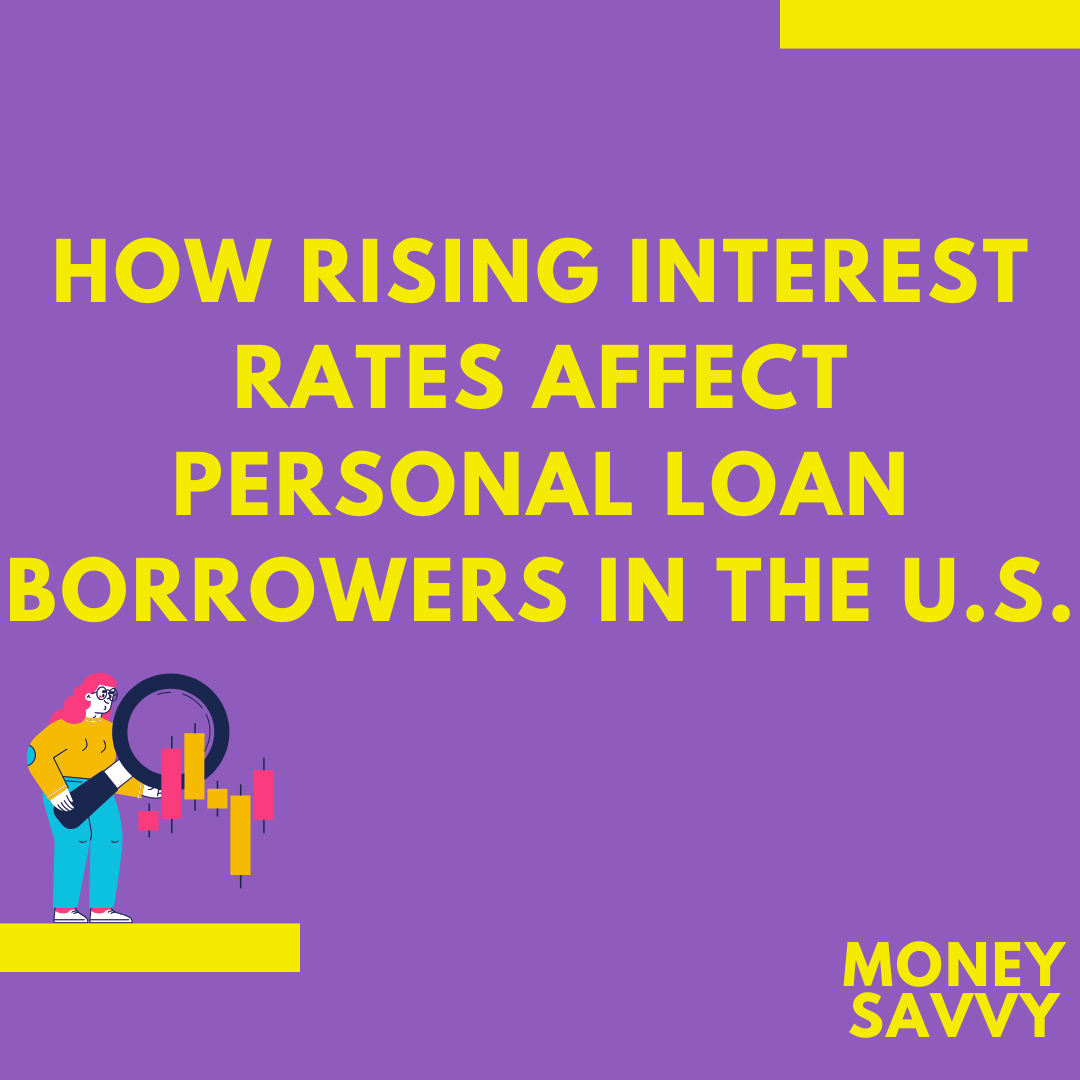How Rising Interest Rates Affect Personal Loan Borrowers in the U.S.: If you’re considering taking out a personal loan or are currently repaying one, you might be concerned about the recent uptick in interest rates and how it affects your finances. Rising interest rates can have a big impact on personal loan borrowers in the U.S., influencing everything from loan affordability to approval rates. This guide breaks down how rising rates might impact you, what you can do to secure a favorable loan, and alternative options to consider.

How Rising Interest Rates Affect Personal Loan Borrowers’ Costs
The biggest impact of rising interest rates on personal loan borrowers is the increase in the cost of borrowing. For personal loan borrowers in the U.S., even a small rate hike can mean higher monthly payments and a greater overall cost by the time the loan is paid off. Here’s a closer look at how these changes can affect borrowers:
- Higher Monthly Payments: As rates climb, borrowers often see their monthly payments increase, especially for variable-rate loans. Fixed-rate loans also tend to be more expensive as lenders adjust to market conditions.
- Increased Total Loan Cost: Over the life of a loan, higher interest rates add up, resulting in borrowers paying substantially more.
- Less Loan Affordability: Rising interest rates affect personal loan borrowers by limiting how much they can afford to borrow, potentially leading them to consider smaller loan amounts.
By understanding these changes, personal loan borrowers in the U.S. can plan for how rising interest rates may impact their budgets.
How Rising Interest Rates Affect Personal Loan Borrowers’ Approval Chances
Rising rates don’t just affect the cost of loans—they also influence how lenders view potential borrowers. As interest rates rise, lenders become more cautious, impacting loan approval in several ways:
- Stricter Credit Requirements: Lenders may increase credit score thresholds to offset the risk associated with higher interest rates, which could make it harder for borrowers with fair or poor credit to qualify.
- Higher Income Requirements: Some lenders may set higher income requirements to ensure that personal loan borrowers in the U.S. can comfortably afford the higher monthly payments.
- Increased Debt-to-Income (DTI) Scrutiny: Lenders may require lower DTI ratios, meaning borrowers with significant existing debt might find it more challenging to qualify for new personal loans.
Understanding these adjustments can help personal loan borrowers anticipate what they need to qualify in this changing landscape.

Alternatives for Personal Loan Borrowers in a High-Interest Environment
For personal loan borrowers in the U.S., rising rates can make personal loans less appealing. However, there are several alternatives that may offer better terms or rates:
- Credit Unions: Credit unions often provide lower rates than traditional banks, which can benefit personal loan borrowers looking for more affordable options.
- Home Equity Loans or HELOCs: Homeowners may consider tapping into their home equity for a lower-rate loan. These options may come with longer terms and lower monthly payments but require using the home as collateral.
- Peer-to-Peer Lending: Peer-to-peer lending platforms sometimes offer competitive rates, especially for borrowers with good credit.
Exploring these alternatives can help personal loan borrowers find affordable financing options even as interest rates rise.
Tips for Personal Loan Borrowers in the U.S. to Secure Better Rates
Navigating the loan landscape during a period of rising interest rates can be tricky, but there are steps personal loan borrowers in the U.S. can take to secure better rates:
- Improve Your Credit Score: Credit scores are critical for securing favorable rates. Pay off outstanding debt, make on-time payments, and limit credit applications.
- Lower Your Debt-to-Income Ratio: Reducing your overall debt can improve your DTI ratio, making you a more attractive borrower.
- Shop Around for the Best Rates: Each lender has different criteria and loan offerings. By comparing lenders, personal loan borrowers can find the best rates available.
- Consider a Shorter Loan Term: While shorter terms mean higher monthly payments, they often come with lower rates, which can save personal loan borrowers money over time.
Future Outlook: What Personal Loan Borrowers in the U.S. Can Expect in the Coming Months
For personal loan borrowers, it’s essential to stay informed about economic forecasts, as rising interest rates may continue. According to industry experts, rates may remain high or even increase further as the Federal Reserve focuses on inflation control. Here’s what personal loan borrowers in the U.S. should keep in mind:
- Continued Rate Fluctuations: Interest rates may continue to fluctuate, so personal loan borrowers should monitor trends and consult with financial advisors as they make borrowing decisions.
- Increased Focus on Credit Health: As rates rise, maintaining a strong credit profile will become increasingly important. Staying financially healthy and minimizing debt can help borrowers keep access to favorable terms.
- Consideration of Fixed-Rate Options: Personal loan borrowers may want to explore fixed-rate loans that offer rate stability in a rising interest rate environment, even if variable rates seem initially attractive.
Conclusion
Rising interest rates affect personal loan borrowers in the U.S. in multiple ways, from loan affordability to eligibility. By understanding how these changes impact borrowing, exploring alternative options, and taking steps to improve their financial health, personal loan borrowers can make well-informed decisions. As we head further into 2024, staying proactive and informed will be crucial for anyone navigating the loan landscape.
